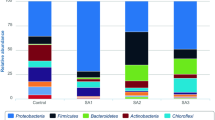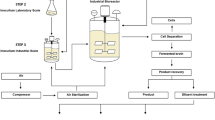Abstract
Soil bacteria that produce biosurfactants can use total petroleum hydrocarbons (TPHs) as a carbon source. This study demonstrated that biosurfactants produced by Burkholderia sp. enhanced the recovery and synergism of soil microbial community, resulting in fast degradation of macro alkanes. Experiments were carried out by applying bio-stimulation after pre-oxidation to investigate the effects of nutrient addition on biosurfactant production, TPH degradation, and microbial community succession in the soil. The results presented that bio-stimulation could produce biosurfactants in high C/N (32.6) and C/H (13.3) conversion after pre-oxidation and increased the total removal rate of TPH (10.59–46.71%). The number of total bacteria had a rapid increase trend (2.94–8.50 Log CFU/g soil). The degradation rates of macro alkanes showed a 4.0-fold (48.07 mg/kg·d−1 versus 186.48 mg/kg·d−1) increase, and the bioremediation time of degrading macro alkanes saved 166 days. Further characterization revealed that the biosurfactants produced by Burkholderia sp. could activate indigenous bacteria to degrade macro alkanes rapidly. A shift in phylum from Actinomycetes to Proteobacteria was observed during bioremediation. The average relative abundance of the microbial community increased from 36.24 to 64.96%, and the predominant genus tended to convert from Allorhizobium (8.57%) to Burkholderia (15.95%) and Bacillus (15.70%). The co-occurrence network and Pearson correlation analysis suggested that the synergism of microbial community was the main reason for the fast degradation of macro alkanes in petroleum-contaminated soils. Overall, this study indicated the potential of the biosurfactants to activate and enhance the recovery of indigenous bacteria after pre-oxidation, which was an effective method to remediate petroleum-contaminated soils.
Graphical Abstract







Similar content being viewed by others
Data availability
The data presented in this study are available in the article.
References
Atakpa EO, Zhou HH, Jiang LJ, Ma YH, Liang YP, Li YH, Zhang DD, Zhang CF (2022) Improved degradation of petroleum hydrocarbons by co-culture of fungi and biosurfactant-producing bacteria. Chemosphere 290:133337
Belcher RW, Huynh KV, Hoang TV, Crowley DE (2012) Isolation of biosurfactant-producing bacteria from the Rancho La Brea Tar Pits. World J Microbiol Biotechnol 28:3261–3267
Conte P, Agretto A, Spaccini R, Piccolo A (2005) Soil remediation: humic acids as natural surfactants in the washings of highly contaminated soils. Environ Pollut 135:515–522
Davin M, Starren A, Deleu M, Lognay G, Colinet G, Fauconnier M (2018) Could saponins be used to enhance bioremediation of polycyclic aromatic hydrocarbons in aged-contaminated soils? Chemosphere 194:414–421
Ebadi A, Sima N, Olamaee M, Hashemi M, Nasrabadi RG (2017) Effective bioremediation of a petroleum-polluted saline soil by a surfactant-producing Pseudomonas aeruginosa consortium. J Adv Res 8:627–633
Fava F, Piccolo A (2002) Effects of humic substances on the bioavailability and aerobic biodegradation of polychlorinated biphenyls in a model soil. Biotechnol Bioeng 77:204–211
Gao BX, Zhu SM, Gu JL, Liu Y, Yi XL, Zhou H (2022) Superoxide radical mediated Mn (III) formation is the key process in the activation of peroxymonosulfate (PMS) by Mn-incorporated bacterial-derived biochar. J Hazard Mater 431:128549
Hoang SA, Lamb D, Sarkar B, Seshadri B, Yu RMK, Tran TKA, O’Connor J, Rinklebe J, Kirkham MB, Vo HT, Bolan NS (2022) Phosphorus application enhances alkane hydroxylase gene abundance in the rhizosphere of wild plants grown in petroleum-hydrocarbon-contaminated soil. Environ Res 204:111924
Hu T, Wang XJ, Zhen LS, Gu J, Zhang KY, Wang QZ, Ma JY, Peng HL, Lei LS, Zhao WY (2019) Effects of inoculating with lignocellulose-degrading consortium on cellulose-degrading genes and fungal community during co composting of spent mushroom substrate with swine manure. Bioresour Technol 291:121876
Jahan R, Bodratti AM, Tsianou M, Alexandridis P (2020) Biosurfactants, natural alternatives to synthetic surfactants: Physicochemical properties and applications. Adv Colloid Interface Sci 275:102061
Kim I, Lee M (2012) Pilot scale feasibility study for in-situ chemical oxidation using H2O2 solution conjugated with biodegradation to remediate a diesel contaminated site. J Hazard Mater 241:173–181
Lai C, Huang Y, Wei Y, Chang J (2009) Biosurfactant-enhanced removal of total petroleum hydrocarbons from contaminated soil. J Hazard Mater 167:609–614
Li DC, Xu WF, Mu Y, Yu HQ, Jiang H, Crittenden JC (2018) Remediation of Petroleum-Contaminated Soil and Simultaneous Recovery of Oil by Fast Pyrolysis. Environ Sci Technol 52:5330–5338
Li Q, Huang Y, Wen D, Fu R, Feng L (2020) Application of alkyl polyglycosides for enhanced bioremediation of petroleum hydrocarbon-contaminated soil using Sphingomonas changbaiensis and Pseudomonas stutzeri. Sci Total Environ 719:137456
Lin TC, Pan PT, Young CC, Chang JS, Chang TC, Cheng SS (2011) Evaluation of the optimal strategy for ex situ bioremediation of diesel oil-contaminated soil. Environ Sci Pollut Res 18:1487–1496
Liu JW, Wei KH, Xu SW, Cui J, Ma J, Xiao XL, Xi BD, He XS (2021) Surfactant-enhanced remediation of oil-contaminated soil and groundwater: a review. Sci Total Environ 756:144142
Ma B, Wang YL, Ye SD, Liu S, Stirling E, Gilbert JA, Faust K, Knight R, Jansson JK, Cardona C, Rottjers L, Xu JM (2020) Earth microbial co-occurrence network reveals interconnection pattern across microbiomes. Microbiome 8:82
Ng YJ, Lim HR, Khoo KS, Chew KW, Chan DJC, Bilal M, Munawaroh HSH, Show PL (2022) Recent advances of biosurfactant for waste and pollution bioremediation: substitutions of petroleum-based surfactants. Environ Res 212:113126
Olasanmi IO, Thring RW (2020) Evaluating rhamnolipid-enhanced washing as a first step in remediation of drill cuttings and petroleum-contaminated soils. J Adv Res 21:79–90
Orta-Martinez M, Rosell-Mele A, Cartro-Sabate M, O’Callaghan-Gordo C, Moraleda-Cibrian N, Mayor P (2018) First evidences of Amazonian wildlife feeding on petroleum-contaminated soils: a new exposure route to petrogenic compounds? Environ Res 160:514–517
Pacwa-Plociniczak M, Czapla J, Plociniczak T, Piotrowska-Seget Z (2019) The effect of bioaugmentation of petroleum-contaminated soil with Rhodococcus erythropolis strains on removal of petroleum from soil. Ecotoxicol Environ Saf 169:615–622
Padmavathi AR, Pandian SK (2014) Antibiofilm activity of biosurfactant producing coral associated bacteria isolated from Gulf of Mannar. Indian J Microbiol 54:376–382
Pei GP, Zhu YE, Cai XT, Shi WY, Li H (2017) Surfactant flushing remediation of o-dichlorobenzene and p-dichlorobenzene contaminated soil. Chemosphere 185:1112–1121
Prakash AA, Prabhu NS, Rajasekar A, Parthipan P, AlSalhi MS, Devanesan S, Govarthanan M (2021) Bio-electrokinetic remediation of crude oil contaminated soil enhanced by bacterial biosurfactant. J Hazard Mater 405:124061
Rahman KSM, Rahman TJ, Kourkoutas Y, Petsas I, Marchant R, Banat IM (2003) Enhanced bioremediation of n-alkane in petroleum sludge using bacterial consortium amended with rhamnolipid and micronutrients. Biores Technol 90:159–168
Ramadass K, Megharaj M, Venkateswarlu K, Naidu R (2018) Bioavailability of weathered hydrocarbons in engine oil-contaminated soil: Impact of bioaugmentation mediated by Pseudomonas spp. on bioremediation. Sci Total Environ 636:968–974
Ren HY, Zhou SY, Wang B, Peng L, Li XG (2020) Treatment mechanism of sludge containing highly viscous heavy oil using biosurfactant. Colloids Surf A-Physicochem Eng Asp 585:124117
Rong L, Zheng X, Oba BT, Shen C, Wang X, Wang H, Luo Q, Sun L (2021) Activating soil microbial community using bacillus and rhamnolipid to remediate TPH contaminated soil. Chemosphere 275:130062
Sherwood MK, Cassidy DP (2014) Modified Fenton oxidation of diesel fuel in arctic soils rich in organic matter and iron. Chemosphere 113:56–61
Silva-Castro GA, Rodelas B, Perucha C, Laguna J, Gonzalez-Lopez J, Calvo C (2013) Bioremediation of diesel-polluted soil using bio-stimulation as post-treatment after oxidation with Fenton-like reagents: Assays in a pilot plant. Sci Total Environ 445:347–355
Suja F, Rahim F, Taha MR, Hambali N, Razali MR, Khalid A, Hamzah A (2014) Effects of local microbial bioaugmentation and bio-stimulation on the bioremediation of total petroleum hydrocarbons (TPH) in crude oil contaminated soil based on laboratory. and field observations. Int Biodeterior Biodegradation 90:115–122
Sutton NB, Grotenhuis T, Rijnaarts H (2014) Impact of organic carbon and nutrients mobilized during chemical oxidation on subsequent bioremediation of a diesel-contaminated soil. Chemosphere 97:64–70
Talvenmäki H, Lallukka N, Survo S, Romantschuk M (2019) Fenton’s reaction-based chemical oxidation in suboptimal conditions can lead to mobilization of oil hydrocarbons but also contribute to the total removal of volatile compounds. Environ Sci Pollut Res 26:34670–34684
Trellu C, Mousset E, Pechaud Y, Huguenot D, van Hullebusch ED, Esposito G, Oturan MA (2016) Removal of hydrophobic organic pollutants from soil washing/flushing solutions: a critical review. J Hazard Mater 306:149–174
Usman M, Hanna K, Faure P (2018) Remediation of oil-contaminated harbor sediments by chemical oxidation. Sci Total Environ 634:1100–1107
Wang M, Sha CY, Wu J, Su JH, Wu JQ, Wang Q, Tan J, Huang SF (2021) Bacterial community response to petroleum contamination in brackish tidal marsh sediments in the Yangtze River Estuary, China. J Environ Sci 99:160–167
Wu M, Li W, Dick WA, Ye X, Chen K, Kost D, Chen L (2017) Bioremediation of hydrocarbon degradation in a petroleum-contaminated soil and microbial population and activity determination. Chemosphere 169:124–130
Wolff DC, Cryder Z, Gan J (2019) Soil bacterial community dynamics following surfactant addition and bioaugmentation in pyrene-contaminated soils. Chemosphere 231:93–102
Xu JL, Fan PQ, Dong YL, Xu L, Zheng YY (2020) Oriented oxidation of all alkanes in soils. J Hazard Mater 399:123078
Xu JL, Li L, Guo Y, Zhang MJ, Huang TL (2018) Novel iron bound to soil organic matter catalyzes H2O2 to oxidize long-chain alkanes effectively in soil. Chem Eng J 339:566–574
Xu JL, Zhang QJ, Li DY, Du J, Wang C, Qin JY (2019) Rapid degradation of long-chain crude oil in soil by indigenous bacteria using fermented food waste supernatant. Waste Manage 85:361–373
Yang ZY, Zu YQ, Zhu JS, Jin MJ, Cui TY, Long XW (2020) Application of biosurfactant as a pH-switchable biodemulsifier for efficient oil recovery from waste crude oil. Chemosphere 240:124946
Yap CL, Gan S, Ng HK (2012) Ethyl lactate-Fenton treatment of soil highly contaminated with polycyclic aromatic hydrocarbons (PAHs). Chem Eng J 200–202:247–256
Zhen L, Gu J, Hu T, Liu C, Jia F, Lü R (2015) Kinetics of petroleum hydrocarbon degradation in soil and diversity of microbial community during composting. Nongye Gongcheng Xuebao/Trans Chinese Soc Agric Eng 31:231–238
Zhen LS, Hu T, Lv R, Wu YC, Chang F, Jia FA, Gu J (2021) Succession of microbial communities and synergetic effects during bioremediation of petroleum hydrocarbon-contaminated soil enhanced by chemical oxidation. J Hazard Mater 410:124869
Zheng X, Aborisade MA, Wang H, He P, Lu S, Cui N, Wang S, Zhang H, Ding H, Liu K (2020) Effect of lignin and plant growth-promoting bacteria (Staphylococcus pasteuri) on microbe-plant Co-remediation: A PAHs-DDTs Co-contaminated agricultural greenhouse study. Chemosphere 256:127079
Funding
This study was supported by the Natural Science Foundation of China (No. 51778524) and the Provincial Natural Science Foundation of Shaanxi (No. 2019ZDLSF06-03).
Author information
Authors and Affiliations
Contributions
All authors contributed to the study conception and design. Jinlan Xu: Methodology, data curation, validation, funding acquisition, supervision. Zezhuang Cao: Methodology, data curation, writing (original draft), validation. Feiyang Chen: Data curation, formal analysis, supervision, methodology. Yuanyuan Li: Data curation, investigation. Jianan Dai: Data curation. Xin Zhang: Data curation.
Corresponding author
Ethics declarations
Ethics approval
Not applicable.
Consent to participate
Not applicable.
Consent for publication
Not applicable.
Competing interests
The authors declare no competing interests.
Additional information
Responsible Editor: Robert Duran
Publisher's note
Springer Nature remains neutral with regard to jurisdictional claims in published maps and institutional affiliations.
Highlights
• Burkholderia sp. produces biosurfactants by regulating C/H and C/N conversions.
• Biosurfactants enhance the recovery of indigenous bacteria after pre-oxidation.
• Synergism of microbial community results in fast degradation of macro alkanes.
• The time of degrading macro alkanes can save 166 days.
Supplementary Information
Below is the link to the electronic supplementary material.
Rights and permissions
Springer Nature or its licensor (e.g. a society or other partner) holds exclusive rights to this article under a publishing agreement with the author(s) or other rightsholder(s); author self-archiving of the accepted manuscript version of this article is solely governed by the terms of such publishing agreement and applicable law.
About this article
Cite this article
Xu, J., Cao, Z., Chen, F. et al. Fast degradation of macro alkanes through activating indigenous bacteria using biosurfactants produced by Burkholderia sp.. Environ Sci Pollut Res 30, 64300–64312 (2023). https://doi.org/10.1007/s11356-023-26909-2
Received:
Accepted:
Published:
Issue Date:
DOI: https://doi.org/10.1007/s11356-023-26909-2




